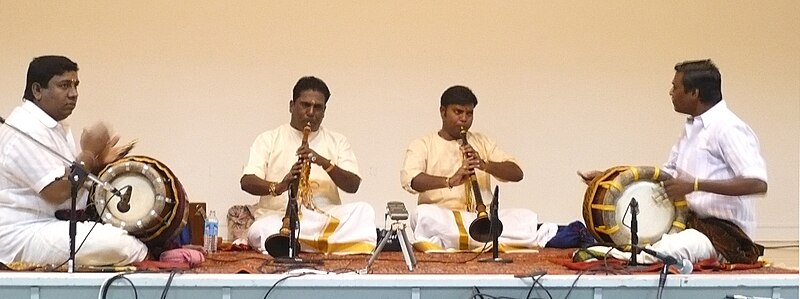Nadaswaroopam G. Ramesh
Reverberations Vol 3
2006
Tracks:
01. Mallari
02. Sri Chakraraja
03. Govardhana
04. Bhagyada Lakshmi
05. Maname Kanamum
06. Raghupathy
07. Abheri - Fusion
08. Thamarai pootha
09. Nadabindu
10. Brahmamokate
11. Harivarasanam
Reverberations Vol 3
2006
Tracks:
01. Mallari
02. Sri Chakraraja
03. Govardhana
04. Bhagyada Lakshmi
05. Maname Kanamum
06. Raghupathy
07. Abheri - Fusion
08. Thamarai pootha
09. Nadabindu
10. Brahmamokate
11. Harivarasanam
♫☆`*♥¸¸.•*¨*•♫☆`*♥¸¸.•*¨*•☆♫
.ღ•:*´♥`*:•ღ.
♫☆`*♥¸¸.•*¨*•☆♫`*♥¸¸.•*¨*•☆♫
.ღ•:*´♥`*:•ღ.
♫☆`*♥¸¸.•*¨*•☆♫`*♥¸¸.•*¨*•☆♫
Mr. Nadaswaroopam G. Ramesh is from Chennai, so he knows how to play the Nadaswaram very well. His music is not classical carnatic music. They call it fusion. And I am posting it for the sound of the Nadaswaram which I love. If you like it too go check one of these many classical Indian blogs... : )
The nadaswaram, nagaswaram, nadhaswaram or nathaswaram, (Tamil: நாதஸ்வரம்) is one of the most popular classical musical instruments in Tamil Nadu and the world's loudest non-brass acoustic instrument. It is a wind instrument similar to the North Indian shehnai but much longer, with a hardwood body and a large flaring bell made of wood or metal.
In South Indian Hindu culture, the nadaswaram is considered to be very auspicious, and it is a key musical instrument played in almost all Hindu weddings and temples of the South Indian tradition. It is part of the family of instruments known as mangala vadya (lit. mangala ["auspicious"], vadya ["instrument"]). The instrument is usually played in pairs, and accompanied by a pair of drums called thavil; it can also be accompanied with a drone from a similar oboe called the ottu.
Construction
The nadaswaram contains three parts namely, kuzhal, thimiru, and anasu. It is a double reed instrument with a conical bore which gradually enlarges toward the lower end. The top portion has a metal staple (mel anaichu) into which is inserted a small metallic cylinder (kendai) which carries the mouthpiece made of reed. Besides spare reeds, a small ivory or horn needle is attached to the instrument, and used to clear the reed of saliva and other debris and allows free passage of air. A metallic bell (keezh anaichu) forms the bottom end of the instrument.
Traditionally the body of the nadaswaram is made out of a tree called aacha although nowadays bamboo, sandalwood, copper, brass, ebony and ivory are also used. For wooden instruments, old wood is considered the best, and sometimes wood salvaged from demolished old houses is used.
The nadaswaram has seven finger-holes, and five additional holes drilled at the bottom which can be stopped with wax to modify the tone. The nadaswaram has a range of two and a half octaves, similar to the Indian bansuri flute, which also has a similar fingering. Unlike the flute where semi and quarter tones are produced by the partial opening and closing of the finger holes, in the nadaswaram they are produced by adjusting the pressure and strength of the air-flow into the pipe. Due to its intense volume and strength it is largely an outdoor instrument and much more suited for open spaces than indoor concerts.
In South Indian Hindu culture, the nadaswaram is considered to be very auspicious, and it is a key musical instrument played in almost all Hindu weddings and temples of the South Indian tradition. It is part of the family of instruments known as mangala vadya (lit. mangala ["auspicious"], vadya ["instrument"]). The instrument is usually played in pairs, and accompanied by a pair of drums called thavil; it can also be accompanied with a drone from a similar oboe called the ottu.
Construction
The nadaswaram contains three parts namely, kuzhal, thimiru, and anasu. It is a double reed instrument with a conical bore which gradually enlarges toward the lower end. The top portion has a metal staple (mel anaichu) into which is inserted a small metallic cylinder (kendai) which carries the mouthpiece made of reed. Besides spare reeds, a small ivory or horn needle is attached to the instrument, and used to clear the reed of saliva and other debris and allows free passage of air. A metallic bell (keezh anaichu) forms the bottom end of the instrument.
Traditionally the body of the nadaswaram is made out of a tree called aacha although nowadays bamboo, sandalwood, copper, brass, ebony and ivory are also used. For wooden instruments, old wood is considered the best, and sometimes wood salvaged from demolished old houses is used.
The nadaswaram has seven finger-holes, and five additional holes drilled at the bottom which can be stopped with wax to modify the tone. The nadaswaram has a range of two and a half octaves, similar to the Indian bansuri flute, which also has a similar fingering. Unlike the flute where semi and quarter tones are produced by the partial opening and closing of the finger holes, in the nadaswaram they are produced by adjusting the pressure and strength of the air-flow into the pipe. Due to its intense volume and strength it is largely an outdoor instrument and much more suited for open spaces than indoor concerts.
and a big hello to Chennai : )
♥
























































+Front.jpg)


















No comments:
Post a Comment